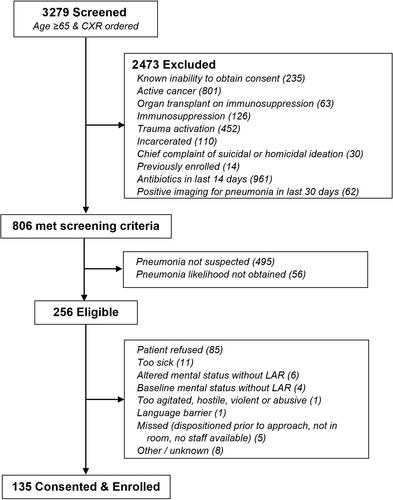Clinical performance of existing diagnostic criteria for pneumonia in older emergency patients: A prospective cohort study
Abstract
Background
Pneumonia accounts for over half a million older adult emergency department (ED) visits annually, but ED pneumonia diagnosis is inaccurate. Geriatric-specific pneumonia diagnostic criteria exist for other settings; no prospective data exist to determine if application in the older adult ED population is feasible. The objective was to prospectively evaluate the utility of four current diagnostic criteria (Loeb; Modified McGeer; Infectious Disease Society of America/American Thoracic Society; American College of Emergency Physicians) in older adult ED patients.
Methods
This was a prospective, observational cohort study of older adult ED patients ≥65 years of age in two U.S. EDs with suspected pneumonia defined as having chest radiography ordered and treating physician suspicion. The standard we used for defining the presence, absence, or inability to determine a diagnosis of pneumonia diagnosis was expert physician chart adjudication. We report the summary statistics for demographic characteristics and symptoms/exam findings and sensitivity, specificity, and likelihood ratios with 95% confidence intervals of the existing diagnostic criteria. Pre-specified cutoff values of a positive LR >10 and a negative LR <0.3 were considered clinically significant.
Results
Of 135 patients enrolled, 27 had pneumonia by adjudicator review. Typical patient-reported pneumonia symptoms, such as fever (18.5%) and new/worse cough (51.9%), were not consistently present in pneumonia. The IDSA/ATS and ACEP criteria had positive LR >10 and negative LR <0.3; however, all confidence intervals included pre-specified cutoffs.
Conclusions
Older adults presented to the ED with low frequency of typical pneumonia symptoms. Although existing diagnostic definitions had promising test characteristics, they may not perform well enough for clinical application without refinement.


 求助内容:
求助内容: 应助结果提醒方式:
应助结果提醒方式:


